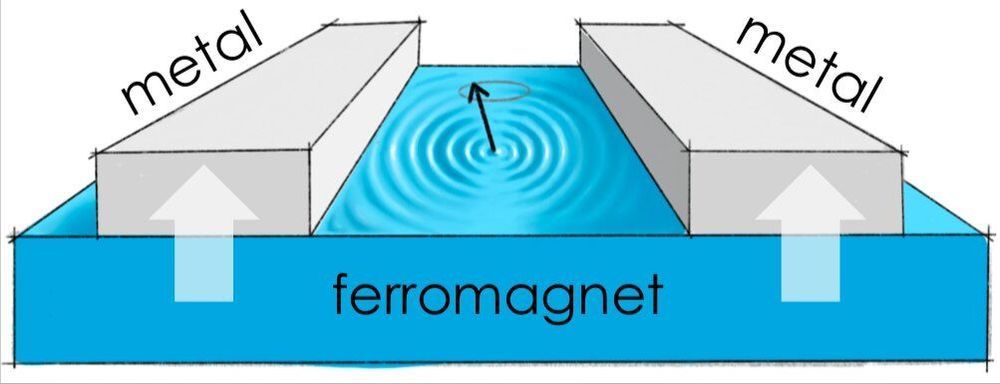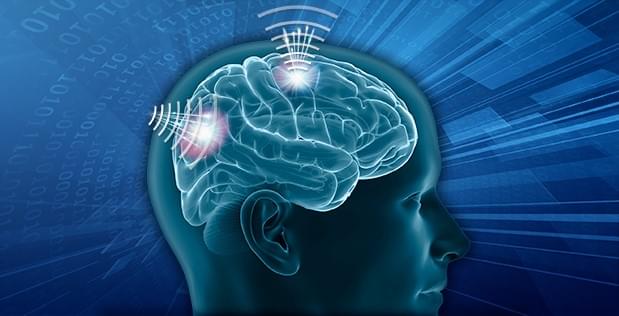Page 8791
May 21, 2019
A method to determine magnon coherence in solid-state devices
Posted by Quinn Sena in categories: particle physics, quantum physics
A team of researchers at Utrecht University, the Norwegian University of Science and Technology and the University of Konstanz has recently proposed a new method to determine magnon coherence in solid-state devices. Their study, outlined in a paper published in Physical Review Letters, shows that cross-correlations of pure spin currents injected by a ferromagnet into two metal leads normalized by their dc value replicate the behavior of the second-order optical coherence function, referred to as g, when magnons are driven far from equilibrium.
“Consider a big room full of people having a party,” Akash Kamra, one of the researchers who carried out the study, told Phys.org. “These people can either behave as in a night club, bumping into each other in an uncoordinated way and with chaotic movements, or the party people might be directed by a common host, such as at a wedding party. Such a ‘condensed’ crowd of people moves swiftly without bumping into each other.”
Kamra draws an analogy between the party situations he described and magnons, quantum particles that correspond to a specific decrease in magnetic strength, traveling as a unit through a magnetic substance. In his analogy, an uncoordinated “party” would occur if magnons are in a “thermal” state, while a coordinated one if they are in a “coherent” or “condensed” state. The coordinated movement of guests in the second type of party, on the other hand, would correspond to a superfluid flow, which is a manifestation of a remarkable state of matter: the condensate.
Continue reading “A method to determine magnon coherence in solid-state devices” »
May 21, 2019
New Quantum Device Can “Generate All Possible Futures”
Posted by Quinn Sena in categories: futurism, quantum physics
…our techniques may enable quantum enhanced AIs to learn the effect of their actions much more efficiently.
May 21, 2019
AI Is Rapidly Augmenting Healthcare and Longevity
Posted by Quinn Sena in categories: life extension, robotics/AI
Conclusion
As Nvidia CEO Jensen Huang has stated, “Software ate the world, but AI is going to eat software.” Extrapolating this statement to a more immediate implication, AI will first eat healthcare, resulting in dramatic acceleration of longevity research and an amplification of the human healthspan.
Next week, I’ll continue to explore this concept of AI systems in healthcare.
Continue reading “AI Is Rapidly Augmenting Healthcare and Longevity” »
May 21, 2019
Commander (ret) Dr. Luis Alvarez, Director of Organ Manufacturing, United Therapeutics, and Co-Founder of GDF11 Harvard spin-out Elevian and MIT spin-out Theradaptive — ideaXme Show — Ira Pastor
Posted by Ira S. Pastor in categories: aging, bioengineering, biotech/medical, business, defense, DNA, health, life extension, military, science

May 21, 2019
Ending Age-Related Diseases Conference: May Update
Posted by Steve Hill in categories: biotech/medical, business, life extension

May is almost over, so it’s time to check in with the Ending Age-Released Diseases conference and see how things are developing with the event.
If you’re unfamiliar with us, we’re hosting our second annual conference at the Cooper Union in New York City on July 11-12th this year. It will feature some of the leading names in both aging research and biotech business and investment coming together to share their knowledge and insights with the audience.
Continue reading “Ending Age-Related Diseases Conference: May Update” »
May 21, 2019
Scientists: Pluto May be Hiding Alien Life in Buried Oceans
Posted by Michael Lance in categories: alien life, habitats
The discovery could mean that other inhospitable habitats may potentially harbor life.
This could mean there are more oceans in the universe than previously thought, making the existence of extraterrestrial life more plausible.
May 21, 2019
A Chip in My Hand Unlocks My House. Why Does That Scare People?
Posted by Zoltan Istvan in categories: bioengineering, business, computing, transhumanism
Nearly 50 years ago, The New York Times—widely considered America’s paper of record—changed the media industry by creating the first modern Op-Ed page. Since then, their Opinion section has arguably become the most important voice for many public ideas that enter and change the world. Everyone from Heads of State to the globe’s most powerful business people to Nobel Prize winners to everyday citizens have written there when they had something essential to say about the times we live in. I’m super excited to share my first Op-Ed for The New York Times on #biohacking and the growing concern of legalizing implants. It’s a happy professional day for me, and an important step forward for the growing #transhumanism movement as we begin to enter mainstream culture.
Implant technology can change the world — unless politicians give in to the hysteria against it.
May 21, 2019
Six Paths to the Nonsurgical Future of Brain-Machine Interfaces
Posted by Paul Battista in categories: biotech/medical, cybercrime/malcode, cyborgs, robotics/AI, wearables
DARPA has awarded funding to six organizations to support the Next-Generation Nonsurgical Neurotechnology (N) program, first announced in March 2018. Battelle Memorial Institute, Carnegie Mellon University, Johns Hopkins University Applied Physics Laboratory, Palo Alto Research Center (PARC), Rice University, and Teledyne Scientific are leading multidisciplinary teams to develop high-resolution, bidirectional brain-machine interfaces for use by able-bodied service members. These wearable interfaces could ultimately enable diverse national security applications such as control of active cyber defense systems and swarms of unmanned aerial vehicles, or teaming with computer systems to multitask during complex missions.
“DARPA is preparing for a future in which a combination of unmanned systems, artificial intelligence, and cyber operations may cause conflicts to play out on timelines that are too short for humans to effectively manage with current technology alone,” said Al Emondi, the N program manager. “By creating a more accessible brain-machine interface that doesn’t require surgery to use, DARPA could deliver tools that allow mission commanders to remain meaningfully involved in dynamic operations that unfold at rapid speed.”
Over the past 18 years, DARPA has demonstrated increasingly sophisticated neurotechnologies that rely on surgically implanted electrodes to interface with the central or peripheral nervous systems. The agency has demonstrated achievements such as neural control of prosthetic limbs and restoration of the sense of touch to the users of those limbs, relief of otherwise intractable neuropsychiatric illnesses such as depression, and improvement of memory formation and recall. Due to the inherent risks of surgery, these technologies have so far been limited to use by volunteers with clinical need.
















